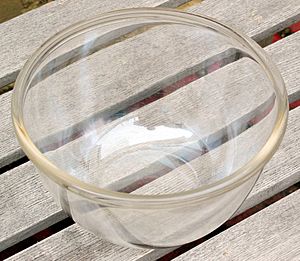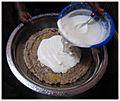Bowl facts for kids
A bowl is a super useful container, usually shaped like half a ball. People use bowls for all sorts of things, especially for holding food. They're great for liquids like soup, and also for solid foods like popcorn or a fresh salad. Bowls come in many sizes and are made from different materials.
Contents
What Are Bowls Used For?
Bowls are perfect for many types of food. Think about your breakfast cereal, a warm bowl of soup, or a scoop of ice cream. They are designed to hold foods that might be a bit messy on a flat plate. Bowls also help keep your food warm or cold, depending on what you're eating. Besides eating, bowls are also used for mixing ingredients when you're cooking or baking.
Materials Bowls Are Made From
Bowls can be made from many different materials. You might have plastic bowls, which are great for picnics or for younger kids because they don't break easily. Glass bowls are often used for mixing ingredients or for serving salads, as you can see what's inside. Ceramic bowls are very common for everyday meals, and some beautiful ones are made from wood. In the past, people also used materials like copper and faience to make bowls.
A Look Back in Time
Bowls are not a new invention! People have been using them for thousands of years. Archeologists have found very old bowls made by ancient civilizations. For example, there are bowls from the Bronze Age in Romania, dating back to about 1550 BC. Ancient Egyptians also used bowls, some made from a material called faience. The Nazca culture in Peru made colorful bowls around 100 BC. These old bowls show us how important and useful bowls have always been to humans around the world.
Images for kids
-
Self-identified bowl performing one of the most common functions of bowls: the serving of food (in this case, chili)
-
Romanian large bowl from the Middle Bronze Age; c. 1550 BC; burnished earthenware; overall: 15.5 × 31.3 cm; Cleveland Museum of Art (U.S.A)
-
Ancient Egyptian bowl; 200–150 BC; faience; 4.8 × 16.9 cm (1.9 × 6.7 in); Metropolitan Museum of Art (New York City)
-
Nasca bowl; c. 100 BC; earthenware with colored slips; diameter: 12.8 × 17.7 cm; overall: 13 cm; from Peru; Cleveland Museum of Art (Cleveland, Ohio, USA)
-
Korean bowl with a lotus petal design in relief; 1100 (Goryeo period); porcelain celadon ware; Cleveland Museum of Art
-
French Neoclassical bowl (jatte à anses relevées or jatte écuelle); 1787–1788; hard-paste porcelain; overall: 7.6 × 25.4 × 19.1 cm; Metropolitan Museum of Art
See also
 In Spanish: Cuenco para niños
In Spanish: Cuenco para niños










